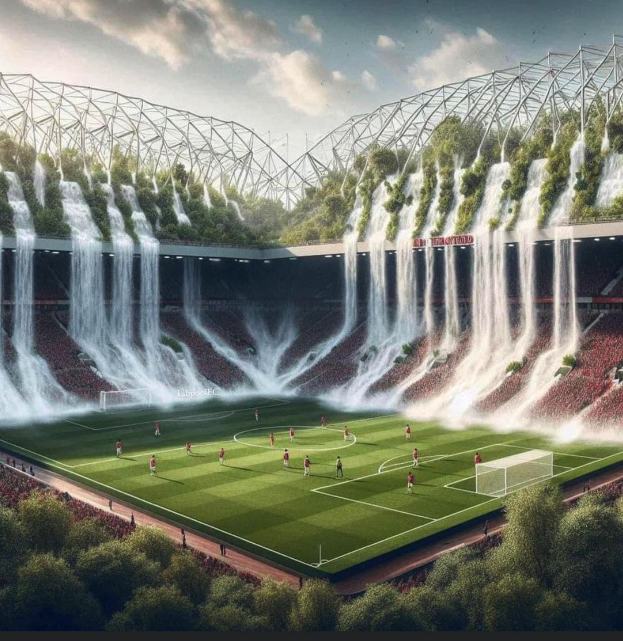
The infamous Old Trafford leaks have again burst forth – and this time with a vengeance and a fury matching that of an end-time holocaust – as the heavens opened up on Sunday this weekend as Manchester United lost 1-0 to Arsenal, with the depressing multiple vignettes of leakage from the roof and flooding from inside the stadium perhaps a gloomy symbolic reminder of the club’s continued downfall under the Glazer ownership.
While it appears of imminent, immediate and paramount importance for the INEOS boss and his new team – that has been scrupulously screened to meet the most exacting of prerequisites to fill the top management vacancies at Old Trafford – to arrest the club’s decade-long, downhill slide on the pitch soonest possible, the question that now inadvertently looms larger than the humiliation faced by all and sundry at the Club is which needs fixing first – the team or the stadium, where the leaks are no longer just sufferable inconveniences that can be ignored?
Manchester United’s highly-anticipated encounter against Arsenal at the Theater of [Wet] Dreams was marred over the weekend by voluminous quantities of rainwater cascading down through their sprawling stadium roof at Old Trafford that was leaking as appallingly as the team’s defense all this while that shamelessly conceded a record 82 goals and famously blowing multiple two-goal leads in various games since the start of the campaign. One could be forgiven for thinking these kinds of scenes, both the porous defense and the watery leaks, do feel aptly symbolic of the underlying litany of problems at United.
The resulting spectacle resembled a chaotic panorama of multiple waterfalls streaming downwards onto the heads of spectators caught totally unprepared for the watery baptism. Despite this being a calamity of humongous proportions, no less, yet the club have seen it fit to apply brakes for the time being to put on hold long-standing plans to fix the issue.
Despite the long and humiliating downward slide of the Club’s reputation on the pitch since their erstwhile doyen Sir Alex Ferguson tendered in his resignation in 2013 is now matched no less by this modern day debacle at the once pristine, awe-inspiring Theater of Dreams at a match that is a vital cog in helping to determine various vital outcomes in the Premier League at this juncture of the entire season.
The once iconic stadium was massively battered by a severe storm that hit Greater Manchester during Sunday’s 1-0 defeat to the Gunners, resulting in rampant flooding in several areas including the players’ tunnel, th away dressing room and several seating areas.
The overall situation is obviously in red alert mode when videos begin to circulate on social media, showing overflowing water copiously pouring down from the south-west corner of the stadium, with water also seen rapidly tumbling off, and forming pools under, seats and near the post-match interview area in the tunnel as well.
United have attributed these waterfall-like cascadences in the south-west corner to an overflow caused by a high volume of water entering the siphonic roof drainage system too quickly.
Possibly in an attempt to mitigate the brevity of the circumstances, the club has admitted that there are ‘sporadic’ leaks in the Old Trafford roof due to wear and tear, which end up becoming a significant problem during periods of heavy rainfall like what happened on the recent Sunday.
In their defense, United have considered the possibility of installing a new roof, although the costly project is unlikely to be undertaken as a penultimate decision can only be made after factoring in the larger issue of stadium redevelopment.
United have apparently detailed plans in place for the replacement of the roof on the Sir Bobby Charlton Stand and this remains an option under consideration. However, this will cost millions, not to mention taking several years, to achieve with the club concerned it would cause significant disruption to stadium operations.
Truth be told, this isn’t the first time fans have been affected by the leaky roof – supporters were drenched by streams of dripping water at the Stretford End back in September during United’s 1-0 loss to Crystal Palace, which led invariably to numerous complaints on social media.
On another incident, just hours before the Manchester derby in April 2019, a severe thunderstorm resulted in water cascading from the roof onto the seats below, prior to United’s 2-0 defeat by City.
United have been quick to highlight that they were not the only ones impacted by Sunday’s heavy rain, with leaks reported at Manchester Airport and flooding at a nearby venue leading to a concert cancellation.
In March, United established a Task Force to investigate all possibilities regarding the redevelopment of Old Trafford, led by Lord Coe with the inclusion of former defender turned Sky pundit Gary Neville.
Options explored include demolishing Old Trafford and constructing a new state-of-the-art stadium on the same site, a project which could cost up to £3billion.
Another possibility is to refurbish Old Trafford, which would not be as expensive as completely demolishing the stadium or take as long as building a brand new arena.
The estimated cost of revamping Old Trafford is around £1bn, but new minority owner Sir Jim Ratcliffe, who heads the task force, is believed to favor constructing a new stadium.

